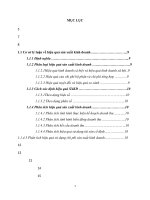Best, R.e. - Phase Locked Loops 6_E_ Design, Simulation, And Applications-Mcgraw-Hill Education (2007).Pdf
Bạn đang xem bản rút gọn của tài liệu. Xem và tải ngay bản đầy đủ của tài liệu tại đây (10.65 MB, 852 trang )
Source : Phase-Locked Loops: Design, Simulation, and Applications, Sixth
Edition Ronald E. Best
1
Introduction to PLLs
Operating Principles of the PLL
The phase-locked loop (PLL) helps keep parts of our world orderly. If we turn on a
television set, a PLL keeps heads at the top of the screen and feet at the bottom. In color
television, another PLL makes sure green remains green and red remains red (even if
politicians claim the reverse is true).
A PLL is a circuit that causes a particular system to track with another one. More
precisely, a PLL is a circuit synchronizing an output signal (generated by an oscillator)
with a reference or input signal in frequency as well as in phase. In the synchronized—
often called “locked”—state, the phase error between the oscillator’s output signal
and the reference signal is zero, or it remains constant.
If a phase error builds up, a control mechanism acts on the oscillator in such a way that
the phase error is again reduced to a minimum. In such a control system, the phase of the
output signal is actually locked to the phase of the reference signal. This is why it is
referred to as a phase-locked loop.
The operating principle of the PLL is explained by the example of the linear PLL
(LPLL). As will be pointed out in Sec. 1.3, other types of PLLs exist—for example,
digital PLLs (DPLLs), all-digital PLLs (ADPLLs), and software PLLs (SPLLs). The PLL
block diagram is shown in Fig. 1.1a and consists of three basic functional blocks:
■ A voltage-controlled oscillator (VCO)
■ A phase detector (PD)
■ A loop filter (LF)
In this simple example, there is no down scaler between the output of VCO [u2(t)] and
the lower input of the phase detector [ω2]. Systems using down scalers are discussed in
the following chapters.
In some PLL circuits, a current-controlled oscillator (CCO) is used instead of the VCO.
In this case, the output signal of the phase detector is a controlled
Printed from Digital Engineering Library @ McGraw-Hill (www.Digitalengineeringlibrary.com).
Copyright ©2004 The McGraw-Hill Companies. All rights reserved.
Any use is subject to the Terms of Use as given at the website.
INTRODUCTION TO PLLS Ronald E. Best
2
Figure 1.1 (a) Block diagram of the PLL. (b) Transfer function of the VCO. (uf = control
voltage; ω2 = angular frequency of the output signal.) (c) Transfer function of
the PD. (
error.)
= average value of the phase-detector output signal; θe = phase
current source rather than a voltage source. However, the operating principle remains the
same. The signals of interest within the PLL circuit are defined as follows:
■ The reference (or input) signal u1(t)
■ The angular frequency ω1 of the reference signal
■ The output signal u2(t) of the VCO
■ The angular frequency ω2 of the output signal
■ The output signal ud(t) of the phase detector
■ The output signal uf(t) of the loop filter
■ The phase error θe, defined as the phase difference between signals u1(t) and u2(t)
3
INTRODUCTION TO PLLS Ronald E. Best
Let us now look at the operation of the three functional blocks in Fig. 1.1a. The VCO
oscillates at an angular frequency ω2, which is determined by the output signal uf of the loop
filter. The angular frequency ω2 is given by
(1.1)
where ω0 is the center (angular) frequency of the VCO and K0 is the VCO gain in rad s−1 V−1.
Equation (1.1) is plotted graphically in Fig. 1.1b. Because rad (radian) is a dimensionless
quantity, we will drop it mostly in this text. (Note, however, that any phase variables used in
this book will have to be measured in radians and not in degrees!) Therefore, in the equations
a phase shift of 180° must always be specified as a value of π.
The PD (also referred to as a phase comparator) compares the phase of the output signal
with the phase of the reference signal and develops an output signal ud(t), which is
approximately proportional to the phase error θe, at least within a limited range of the latter
(1.2)
Here, Kd represents the gain of the PD. The physical unit of Kd is V/rad. Figure 1.1c is a
graphical representation of Eq. (1.2).
The output signal ud(t) of the PD consists of a DC component and a superimposed AC
component. The latter is undesired; hence, it is canceled by the loop filter. In most cases, a
first-order low-pass filter is used. Let us now see how the three building blocks work together.
First, we assume the angular frequency of the input signal u1(t) is equal to the center
frequency ω0. The VCO then operates at its center frequency ω0. As we see, the phase error θe
is zero. If θe is zero, the output signal ud of the PD must also be zero. Consequently, the output
signal of the loop filter uf will also be zero. This is the condition that permits the VCO to
operate at its center frequency.
If the phase error θe were not zero initially, the PD would develop a nonzero output signal
ud. After some delay, the loop filter would also produce a finite signal uf. This would cause the
VCO to change its operating frequency in such a way that the phase error finally vanishes.
Assume now that the frequency of the input signal is changed suddenly at time t0 by the
amount Δω. As shown in Fig. 1.2, the phase of the input signal then starts leading the phase of
the output signal. A phase error is built up and increases with time. The PD develops a signal
ud(t), which also increases with time. With a delay given by the loop filter, uf(t) will also rise.
This causes the VCO to increase its frequency. The phase error becomes smaller now, and
after some settling time the VCO will oscillate at a frequency that is exactly the frequency of
the input signal. Depending on the type of loop filter used, the final phase error will have been
reduced to zero or to a finite value.
The VCO now operates at a frequency which is greater than its center frequency ω0 by an
amount Δω. This will force the signal uf(t) to settle at a final
INTRODUCTION TO PLLS Ronald E. Best
4
Figure 1.2 Transient response of a PLL onto a step variation of the reference frequency. (a)
Reference signal u1(t). (b) Output signal u2(t) of the VCO. (c) Signals
and θe
(t) as a function of time. (d) Angular frequency ω2 of the VCO and loop filter
output signal uf(t) as a function of time. (e) Angular frequency ω1 of the reference
signal u1(t).
value of uf = Δω/K0. If the center frequency of the input signal is frequency-modulated by an
arbitrary low-frequency signal, then the output signal of the loop filter is the demodulated
signal.
The PLL can consequently be used as an FM detector. As we shall see later, it can be
further applied as an AM or PM detector.
One of the most intriguing capabilities of the PLL is its ability to suppress noise
superimposed on its input signal. Let us suppose that the input signal of the PLL is buried in
noise. The PD tries to measure the phase error between input and output signals. The noise at
the input causes the zero crossings of the input signal u1(t) to be advanced or delayed in a
stochastic manner. This causes the PD output signal ud(t) to jitter around an average value. If
the corner frequency of the loop filter is low enough, almost no noise will be noticeable in the
signal uf(t), and the VCO will operate in such a way that the phase of the signal
Printed from Digital Engineering Library @ McGraw-Hill (www.Digitalengineeringlibrary.com).
Copyright ©2004 The McGraw-Hill Companies. All rights reserved.
Any use is subject to the Terms of Use as given at the website.
INTRODUCTION TO PLLS Ronald E. Best
5
u2(t) is equal to the average phase of the input signal u1(t). Therefore, we can state that the
PLL is able to detect a signal that is buried in noise. These simplified considerations have
shown that the PLL is nothing but a servo system that controls the phase of the output signal
u2(t).
As shown in Fig. 1.2, the PLL was always able to track the phase of the output signal to the
phase of the reference signal; this system was locked at all times. This is not necessarily the
case, however, because a larger frequency step applied to the input signal could cause the
system to “unlock.” The control mechanism inherent in the PLL will then try to become
locked again, but will the system indeed lock again? We shall deal with this problem in the
following chapters. Basically two kinds of problems must be considered:
■ The PLL is initially locked. Under what conditions will the PLL remain locked?
■ The PLL is initially unlocked. Under what conditions will the PLL become locked?
If we try to answer these questions, we notice that different PLLs behave quite differently in
this regard. We find there are some fundamentally different types of PLLs. We will identify
these various types in Sec. 1.3.
Historical Background
The French engineer Henri de Bellescize is considered to be the inventor of the PLL. His very
first implementation goes back to the year 1932. De Bellescize published his vacuum tube
circuit in the French journal L’Onde Electrique.22 The actual schematic is given in Fig. 1.3
and will probably look familiar only to a
Figure 1.3 De Bellescize’s PLL circuit of the year 1932.
INTRODUCTION TO PLLS Ronald E. Best
6
few veterans who started their career with building ham radios from electron tubes. The tube
on the right side of the figure in combination with the LC tank circuit forms an oscillator, and
as we will recognize soon, it is even a voltage-controlled oscillator. The output signal of the
oscillator [labeled H and corresponding to u2(t) in Fig. 1.1a] is capacitively coupled to the grid
of the tube on the left. The reference signal [labeled S and corresponding to u1(t) in Fig. 1.1a]
is also fed via another capacitor to that grid. Because the grid voltage–anode current
characteristic of electron tubes is nonlinear, the anode current contains a product term that is, a
signal proportional to S · H or u1(t) · u2(t). As will be shown in Sec. 2.4.1, the circuit
around the left tube is a multiplier type phase detector. When the circuit is locked, this product
is a measure of phase error—in other words, of the phase difference between the signals S and
H. The parallel RC circuit in the anode is the loop filter. The voltage drop across that filter is
therefore proportional to the phase error. That voltage applied to the anode of the right tube is
now the difference of the battery voltage (e) and the voltage drop across resistor R—that is,
the phase error modulates the anode voltage of the oscillator. Because the frequency generated
by the oscillator is an almost linear function of anode voltage, the oscillator is a VCO indeed!
This brilliant invention was widely ignored by most engineers for about 20 years. One of
the first large-scale industrial applications of the PLL (back in the 1950s) was the color
subcarrier recovery in color TV receivers. PLL-like circuits were also used in TV for line and
frame synchronization. Somewhat later frequency synthesizers built from PLLs were used to
generate a raster of frequencies in the local oscillator of FM receivers. The real breakthrough
of the PLL came with desktop computers and with the PC, where PLLs are used for many
types of data synchronization—for instance, reading digital data to and from floppy disks,
hard disks, modems, tape drives, and the like. One of the largest applications today is probably
the mobile phone, where the PLL is used again for frequency synthesis.
Classification of PLL Types
The very first phase-locked loops (PLLs) were built from discrete components, including
electron tubes and, later, discrete transistors. All these circuits were linear circuits. The first
PLL ICs appeared around 1965 and were also purely analog devices. An analog multiplier
(four-quadrant multiplier) was used as the phase detector, the loop filter was built from a
passive or active RC filter, and the well-known voltage-controlled oscillator (VCO) was used
to generate the output signal of the PLL. This type of PLL is referred to as the linear PLL
(LPLL) today. In the years that followed, the PLL drifted slowly but steadily into digital
territory. The very first digital PLL (DPLL), which appeared around 1970, was in effect a
hybrid device: only the phase detector was built from a digital circuit (for instance, from an
EXOR gate or a JK-flipflop), but the remaining blocks were still analog. A few years later, the
“all-digital” PLL (ADPLL) was invented. The ADPLL is exclusively built from digital
function blocks; hence, it doesn’t contain any passive components like resistors and
capacitors.
Printed from Digital Engineering Library @ McGraw-Hill (www.Digitalengineeringlibrary.com).
Copyright ©2004 The McGraw-Hill Companies. All rights reserved.
Any use is subject to the Terms of Use as given at the website.
INTRODUCTION TO PLLS Ronald E. Best
7
In analogy to filters, PLLs can also be implemented “by software.” In this case, the
function of the PLL is no longer performed by a piece of specialized hardware, but rather by a
computer program. This last type of PLL is referred to as SPLL.
Different types of PLLs behave differently, so there is no common theory which covers all
kinds of PLLs. The performance of LPLLs and DPLLs is similar, however; thus, we can
develop a theory that is valid for both categories. We will deal with LPLLs and DPLLs in
Chaps. 2 and 3. The term “mixed” indicates that these PLLs are mostly hybrids built from
linear and digital circuits. Strictly speaking, only the DPLL is a mixed-signal circuit; the LPLL
is purely analog.
The ADPLL behaves very much different from mixed-signal PLLs; hence, it is discussed in
a separate chapter (Chap. 11).
The software PLL is normally implemented by a hardware platform such as a
microcontroller or a digital signal processor (DSP). The PLL function is realized by software.
This offers the greatest flexibility because a vast number of different algorithms can be
developed. For example, an SPLL can be programmed to behave like an LPLL, a DPLL, or an
ADPLL. We will deal with SPLLs in Chap. 13.
Printed from Digital Engineering Library @ McGraw-Hill (www.Digitalengineeringlibrary.com).
Copyright ©2004 The McGraw-Hill Companies. All rights reserved.
Any use is subject to the Terms of Use as given at the website.
Source : Phase-Locked Loops: Design, Simulation, and Applications, Sixth
Edition Ronald E. Best
9
Mixed-Signal PLL Building Blocks
Block Diagram of the Mixed-Signal PLL
As mentioned in Sec. 1.3, the mixed-signal PLL includes circuits that are hybrids of both
linear and digital circuits. To see which parts of the system are linear and which are
digital, consider the general block diagram in Fig. 2.1.
As shown in Sec. 1.1, every PLL consists of the three blocks phase detector, loop
filter, and VCO (voltage-controlled oscillator). When the PLL is used as a frequency
synthesizer, another block is added: a divide-by-N counter. Assuming the counter divides
by a factor N, the frequency of the VCO output signal is then forced to be N times the
reference frequency (the frequency of the input signal u1). In most cases, the divider ratio
N is made programmable. We will deal extensively with frequency synthesizers in Chaps.
6 and 7.
By inserting a down scaler, the term center frequency becomes ambiguous: the center
(radian) frequency ω0 can be related to the output of the VCO (as done in Sec. 1.1), but it
could also be related to the output of the down scaler, or in other words, to the input of
the PLL. To remove this dilemma, we introduce two different terms for center (radian)
frequency: we will use the symbol ω0 to denote the center frequency at the output of the
VCO, and the symbol ω0′ to denote the center radian frequency at the input of the PLL.
Obviously, ω0 and ω0′ are related by ω0′ = ω0/N. As shown in Fig. 2.1, the quantities
related to the output signal of the down scaler are characterized by a prime (′symbol)—
for example, u2′, ω2′. When the VCO does not operate at its center frequency (uf ≠
0), its output radian frequency is denoted as ω2. For the down-scaled frequency, the
symbol ω2′ is used, as shown in Fig. 2.1. Again, we have ω2′ = ω2/N.
As will be demonstrated later in this chapter, the order (number of poles of the transfer
function) of a PLL is equal to the order of the loop filter +1. In most practical PLLs, firstorder loop filters are applied. These PLLs are therefore second-order systems. In a few
cases, the filter may be omitted (such a PLL is a first-order loop). In this chapter, we will
deal exclusively with first- and
Printed from Digital Engineering Library @ McGraw-Hill (www.Digitalengineeringlibrary.com).
Copyright ©2004 The McGraw-Hill Companies. All rights reserved.
Any use is subject to the Terms of Use as given at the website.
10
MIXED-SIGNAL PLL BUILDING BLOCKS Ronald E. Best
Figure 2.1 Block diagram of the mixed-signal PLL. The symbols defined here are used
throughout this chapter. The divide-by-N counter is optional.
second-order PLLs. Higher-order loops come into play when suppression of spurious
sidebands (also called “spurs”) becomes an issue. The designer of the PLL then has to
provide higher-order loop filters10—that is, loop filters of order 2, 3, or even 4.
Increasing the order also increases the phase shift of such filters, thus higher-order PLLs
are prone to become unstable. We will deal with higher-order (>2) PLLs in a separate
chapter (Chap. 9), where we will show how to specify the poles and zeros of higher-order
loop filters in order to maintain stable operation.
As was explained in Sec. 1.1, the PLL is nothing more than a control system which acts
on the VCO in such a way that the frequency of the signal u2′ is identical with the
frequency of signal u1. Moreover, the phase of signal u2′ is nearly identical with the
phase of signal u1 or is offset by a nearly constant value from the latter. The PLL can
therefore be considered as a control system for phase signals. Because phase signals are
less frequently found in control theory than voltage or current signals, for instance, we
will consider the nature of phase signals in more detail in Sec. 2.2. The properties of the
PLL’s building blocks will be discussed in Sec.2.4 through 2.7.
A Note on Phase Signals
Dynamic analysis of control systems is normally performed by means of its transfer
function H(s). H(s) relates the input and output signals of the system; in conventional
electrical networks, the input and the output are represented by voltage signals u1(t) and
u2(t), respectively, so H(s) is given by
(2.1)
where U1(s) and U2(s) are the Laplace transforms of u1(t) and u2(t), respectively, and s is
the Laplace operator. In the case of the PLL, the input and output signals are phases,
however, which is less familiar to many electronic engineers.
11
MIXED-SIGNAL PLL BUILDING BLOCKS Ronald E. Best
To see what phase signals really are, we assume for the moment that both input and output
signals of the PLL (Fig. 2.1) are sine waves:
(2.2)
The information carried by these signals is neither the amplitude (U10 or U20, respectively)
nor the frequency (ω1 or ω2′, respectively) but the phases θ1(t) and θ2′(t).
Note: Because we used the symbol ω2′ for the radian frequency at the output of the down
scaler (Fig. 2.1), we use the symbol θ2′ for the phase of signal u2′ and not θ2; the latter is
used to specify the phase of the VCO output signal u2.
Let us now consider some simple phase signals. Figure 2.2 lists a number of phase signals
θ1(t), which are frequently used to excite a PLL. Figure 2.2a shows
Figure 2.2 Some typical exciting functions as applied to the reference input of a PLL. (a) Phase step a
at t = 0; θ1(t) = ΔΦ · u(t). (b) Frequency step Δω applied at t = 0; θ1(t) =Δω·t. (c) Frequenc
starting at t = 0; θ1(t) = Δω t2/2.
Printed from Digital Engineering Library @ McGraw-Hill (www.Digitalengineeringlibrary.com).
Copyright ©2004 The McGraw-Hill Companies. All rights reserved.
Any use is subject to the Terms of Use as given at the website.
12
MIXED-SIGNAL PLL BUILDING BLOCKS Ronald E. Best
the simplest case: the phase θ1(t) performs a step change at time t = 0; hence, it is given by
(2.3)
where u(t) is the unit step function. This case is an example for phase modulation.
Let us consider next an example of frequency modulation (Fig. 2.2b). Assume the angular
frequency of the reference signal is ω0′ for t < 0. At t = 0, the angular frequency is abruptly
changed by the increment Δω. For t ≥ 0, the reference signal is consequently given by
(2.4)
In this case, the phase θ1(t) can be written as
(2.5)
Consequently, the phase θ1(t) is a ramp signal.
As a last example, consider a reference signal whose angular frequency is ω0′ for t < 0
and increases linearly with time for t ≥ 0 (Fig. 2.2c). For t ≥ 0, its angular frequency is
therefore
(2.6)
where
denotes the rate of change of angular frequency. Remember that the angular
frequency of a signal is defined as the first derivative of its phase with respect to time:
(2.7)
Hence the phase of a signal at time t is the integral of its angular frequency over the time
interval 0 < τ < t, where τ denotes elapsed time. The reference signal can be written as
(2.8)
Consequently, the corresponding phase signal θ1(t) is given by
(2.9)
in other words, it is a quadratic function of time.
Building Blocks of Mixed-Signal PLLs
As shown in Fig. 2.1, a mixed-signal PLL is set up from four different building blocks: phase
detector, loop filter, controlled oscillator, and (optionally) down
Printed from Digital Engineering Library @ McGraw-Hill (www.Digitalengineeringlibrary.com).
Copyright ©2004 The McGraw-Hill Companies. All rights reserved.
Any use is subject to the Terms of Use as given at the website.
13
MIXED-SIGNAL PLL BUILDING BLOCKS Ronald E. Best
scaler. We will discuss the properties of phase detectors in Sec. 2.4, the loop filters in Sec. 2.5,
controlled oscillators in Sec. 2.6, and down scalers in Sec. 2.7.
Phase Detectors
A phase detector is a circuit capable of delivering an output signal that is proportional to the
phase difference between its two input signals u1 and u2′ (cf. Fig. 2.1). Many circuits could
be applied. In mixed signal PLLs, mainly four types of phase detectors are used. The first
phase detector in the history of the PLL was the linear multiplier (also referred to as fourquadrant multiplier). When the PLL moved into digital territory, digital phase detectors
become popular, such as the EXOR gate, the edge-triggered JK-flipflop and the so-called
phase-frequency detector (PFD). Let us start with the discussion of the multiplier phase
detector.
Type 1: Multiplier phase detectors
The multiplier phase detector is used exclusively in linear PLLs (LPLLs). In a LPLL, the input
signal u1 is mostly a sine wave and is given by
(2.10a)
where U10 is the amplitude of the signal, ω1 is its radian frequency, and θ1 its phase. The
second input signal u2′ (cf. also Fig. 2.1) is usually a symmetrical square wave signal
(sometimes also called Walsh function)21 and is given by
(2.10b)
where rect stands for “rectangular” (square wave), and U20 is the amplitude, ω2′ the
radian frequency and θ2′ the phase. These signals are shown in Fig. 2.3. The dashed curve in
Fig. 2.3a is a sine wave having a phase of θ1 = 0; the solid line has a nonzero phase θ1. For
simplicity, we assume here that the phase is constant over time. The dashed curve in Fig. 2.3b
shows a symmetrical square wave having a phase θ2′ = 0; the solid line has a nonzero phase.
The output signal of the four-quadrant multiplier is obtained by multiplying the signals u1 and
u2′. To simplify the analysis, the square wave signal is replaced by its Fourier series. For
u2′(t), we then get
(2.11)
The first term in square brackets is the fundamental component; the remaining terms are
odd harmonics. For the output signal ud(t), therefore we get
(2.12)
Printed from Digital Engineering Library @ McGraw-Hill (www.Digitalengineeringlibrary.com).
Copyright ©2004 The McGraw-Hill Companies. All rights reserved.
Any use is subject to the Terms of Use as given at the website.
14
MIXED-SIGNAL PLL BUILDING BLOCKS Ronald E. Best
Figure 2.3 Input signals of the multiplier phase detector. (a) Signal u1(t) is a sine wave.
Dashed line: phase θ1 = 0; solid line: phase θ1 > 0. (b) Signal u2′(t) is a
symmetrical square wave signal. Dashed line: θ2′ = 0; solid line: θ2′ > 0.
When the PLL is locked, the frequencies ω1 and ω2′ are identical, and ud(t) becomes
(2.13)
where θe = θ1 − θ2′ is the phase error. The first term of this series is the wanted “DC”
term, whereas the higher-frequency terms will be eliminated by the loop filter. Setting Kd =
2U10U20/π and neglecting higher-frequency terms, we get
(2.14)
where Kd is called detector gain. When the phase error is small, the sine function can be
replaced by its argument, and we get
(2.15)
This equation represents the linearized model of the phase detector.
Printed from Digital Engineering Library @ McGraw-Hill (www.Digitalengineeringlibrary.com).
Copyright ©2004 The McGraw-Hill Companies. All rights reserved.
Any use is subject to the Terms of Use as given at the website.
15
MIXED-SIGNAL PLL BUILDING BLOCKS Ronald E. Best
Figure 2.4 Phase-detector gain Kd as a function of the amplitude U10 of the reference signal.
The dimension of Kd is V/rad. As shown earlier, Kd is proportional to both amplitudes U10
and U20. Normally, U20 is constant, so Kd becomes a linear function of the input signal level
U10. This is plotted in Fig. 2.4. Because the multiplier saturates when its output signal comes
close to the power supply rails, this function flattens out at large signal levels, and Kd
approaches a limiting value. To conclude the analysis of the four-quadrant multiplier, we state
that—in the locked state of the PLL—the phase detector represents a zero-order block having
a gain of Kd.
To complete the discussion of the multiplier-type phase detector, we look at its behavior in
the unlocked state of the PLL. When the PLL is out of lock, the radian frequencies ω1 and
ω2′ are different. The output signal of the multiplier then can be written as
(2.16)
The higher harmonics are almost entirely suppressed by the loop filter, hence there remains
one AC term whose frequency equals the difference ω1 − ω2′. Because the output is an AC
signal, we are tempted to conclude that its average is zero. This would imply that the average
output signal of the loop filter would also be zero (cf. Fig. 2.1). This would make it impossible
for the loop to acquire lock because the frequency of the VCO output signal would remain
permanently hung up at its center frequency ω0, with a superimposed frequency modulation.
As we will see in Sec. 3.9.3, however, the AC signal ud(t) is an asymmetric “sine wave”—
that is, the durations of the positive and negative half waves are different. Consequently, there
will be a nonzero DC component that will pull the average output frequency of the VCO up or
down until lock is acquired, provided the initial difference of radian frequencies ω1 − ω2′ is









